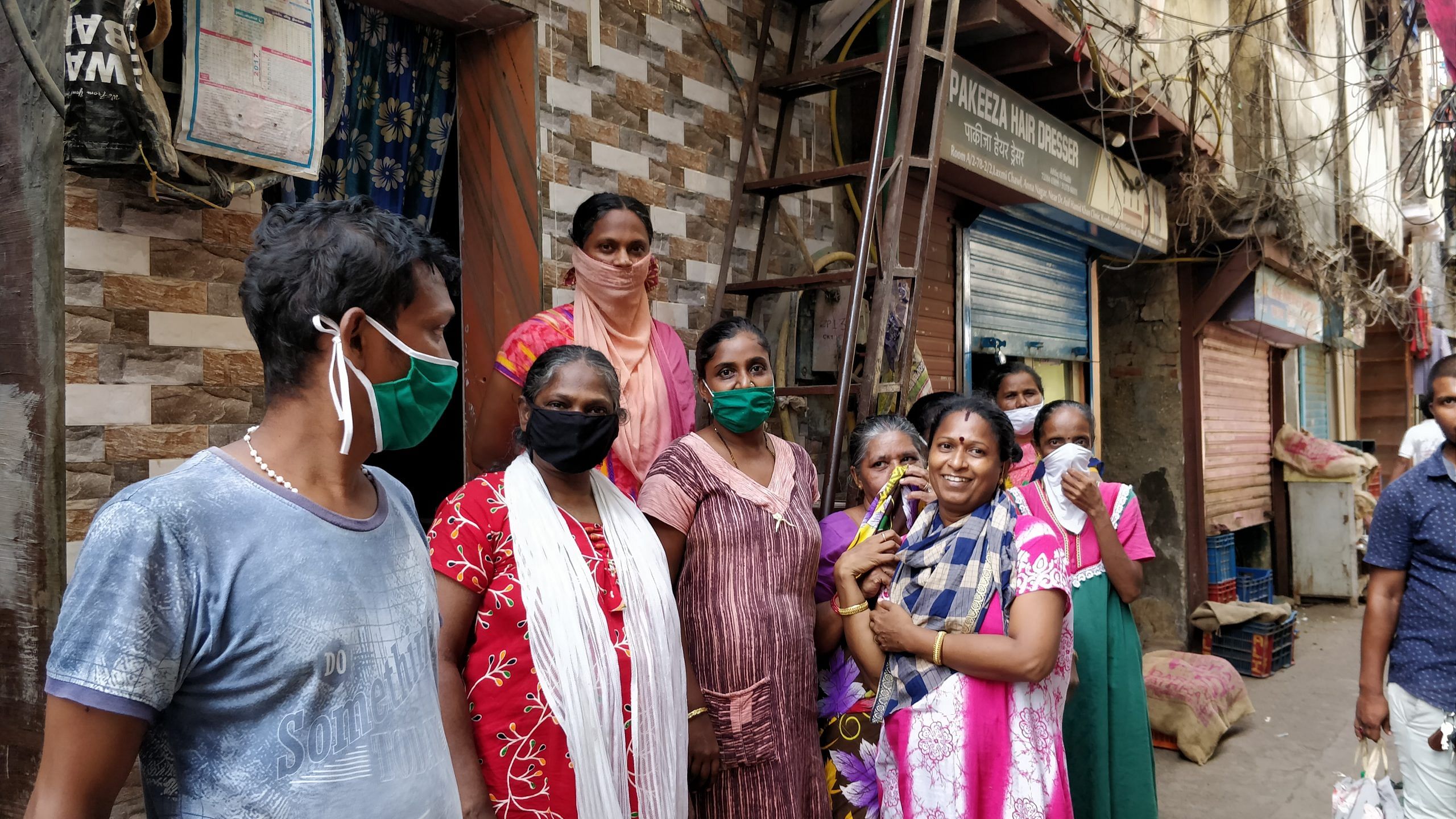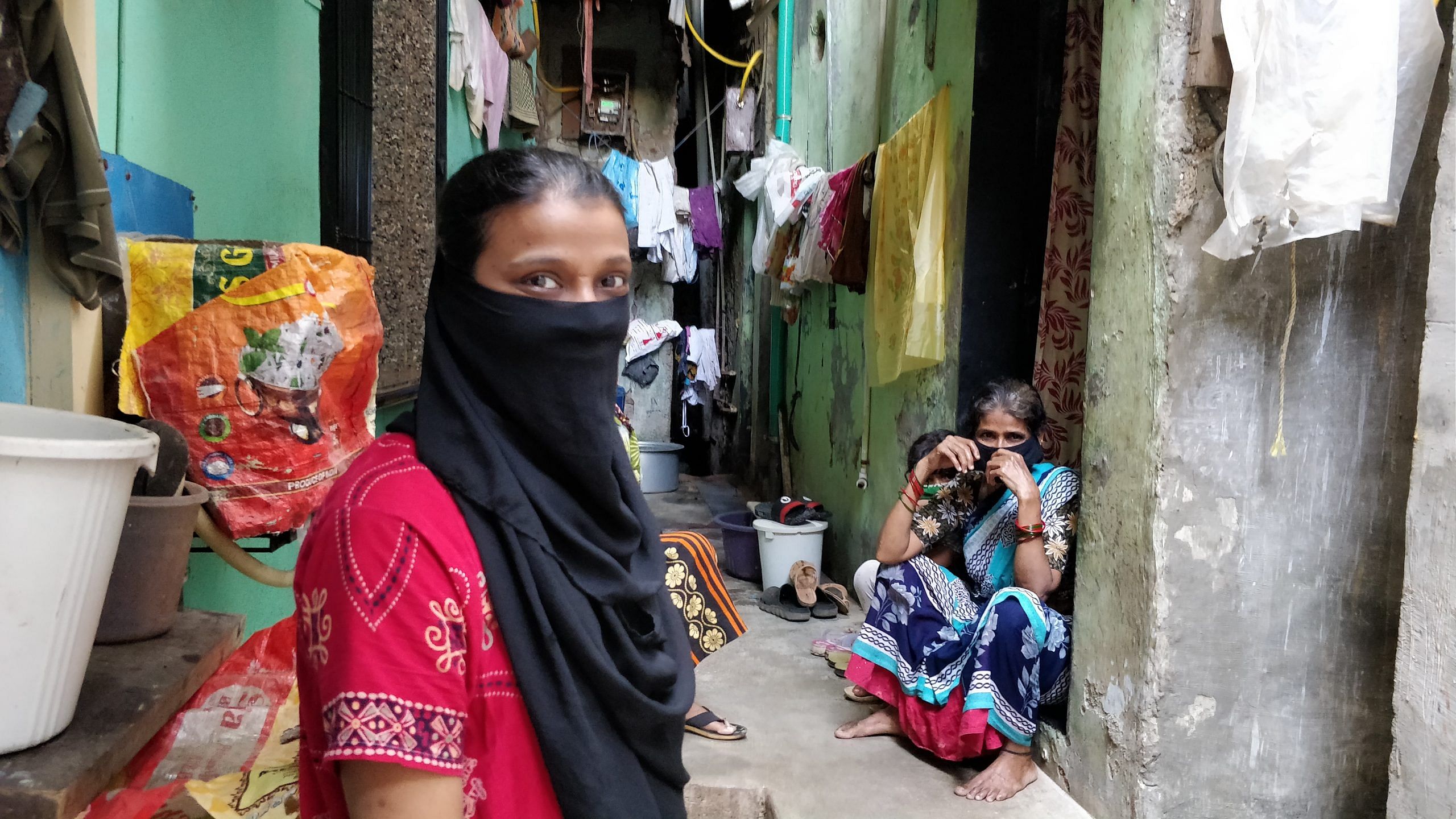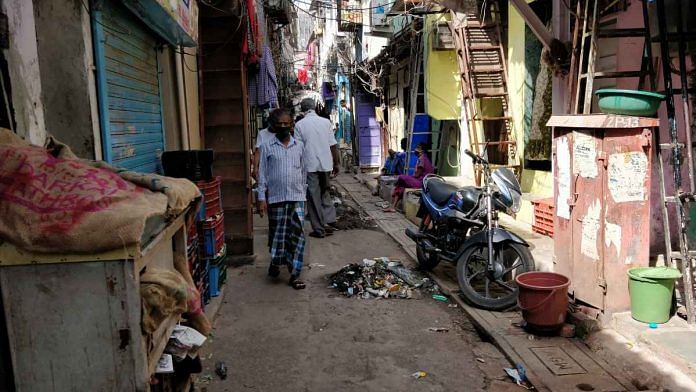Mumbai: India’s financial capital Mumbai has borne the brunt of the ongoing Covid-19 onslaught. As many as 80 per cent of Maharashtra’s patients have been reported from Mumbai, which had recorded 24,118 cases by Thursday. Of this, around 1,300 cases come from Dharavi, one of Asia’s biggest slums, where the high population density flies in the face of every social distancing guideline.
Spread over an area of 2.4 square kilometres, Dharavi is home to around 8.5 lakh people. Its population density of 3.54 lakh people per square kilometre far surpasses that of Mumbai, which ranks among the world’s most densely-populated cities.
No wonder then that Dharavi has occupied special focus as authorities in Mumbai try to battle the growth of a highly infectious disease that has already killed over 50 people in the slum.
While the Mumbai administration claims it’s doing its best, residents of Dharavi are far from pleased as they recount the several “shortcomings” in the authorities’ efforts. Many claim that the screening is sporadic and that the lockdown aid promised by the government is not reaching them. The cramped communal toilets, each shared by thousands, lie dirty, further heightening their fears, they add.
The impact of the bad press they receive is just as severe, residents say, noting that they will probably have to battle the stigma of living in a “hotspot” for a long time to come.
Also Read: HCQ to be tested on thousands in Mumbai’s Dharavi and Worli to prevent Covid-19 spread
In the heart of Mumbai
Dharavi lies in the heart of Mumbai, near prominent pockets like Bandra and less than 10 km from the Chhatrapati Shivaji International Airport. Its patchwork of roofs is, in fact, one of the first glimpses of Mumbai as people fly into the city.
It is home to small-scale industries worth $1 billion and large numbers of migrant workers live and work here in small spaces. The small living quarters here — roughly one-sixth the size of a regular one-room-kitchen unit accommodate roughly seven to eight members of a family. As many as 70 per cent of the residents here use community toilets. In short, social distancing is next to impossible to impose in Dharavi.
When the ThePrint visited Dharavi’s Muslim Nagar on 17 May, a large number of people were out and about, on the road or just sitting outside their homes, many without covering their faces.
Among these people were young men carrying bags on their shoulders, ready to leave Mumbai for their hometowns in Uttar Pradesh and Bihar. In other areas, crowds gathered as volunteers distributed hot food.

Kiran Dighavkar, 38, the assistant municipal commissioner for G North ward, which includes the central suburbs of Dadar, Mahim and Dharavi, said enforcing a strict lockdown is difficult in slums.
“This is why the strategy in Dharavi is to screen maximum people, institutionally quarantine them and treat them, all while they remain in Dharavi,” he added.
Also Read: Authentic numbers are absent, Covid-19 crisis has exposed India’s data-ignorance
‘No provisions, no livelihood’
Speaking to ThePrint, many residents said they were resentful about their portrayal as a “dangerous place” even as they battle institutional apathy amid a lockdown that has left them jobless and helpless.
“They say Dharavi is such a dangerous place but there are no facilities here,” said Savera Kaji, a woman in her 50s. There are two breadwinners in her family of seven but both are “sitting at home” right now.
Rashid, a cycle shop owner who has lived in Muslim Nagar for 27 years, claimed the slum was a victim of inaccurate portrayal. “Where are the cases? In this whole area, find me one positive case,” added Rashid.
Malar, whose driver husband has been out of work for two months, had other concerns. “How will we go to work now that Dharavi is badnaam (infamous) for having the highest number of coronavirus cases?” she said.
Kaji had other allegations too. She said they had received foodgrains only once and nothing since then. “Over the last three months, no MLA, corporator has visited this area, dare they come and ask for votes now, we will drive them away,” she said. Pointing to a road flooded with drain water, she said local leaders failed to clean their slum but “expect us to stay indoors and fight the disease”.
Many other residents said local politicians had launched community kitchens to offer food, but added that they were catering to their own communities or acquaintances. “We created a list of 1,000 needy families needing rations but the local corporator refused to help, saying he didn’t receive votes from here,” Mashook Ali Khan, a social worker, said.
Local leaders denied the allegation. Vakil Ahmed, a Congress leader who serves as the corporator, said he had been “visiting the area every few days, despite being unwell, and have helped as many people as I can”.
“If someone says I haven’t, let them show me the recording,” he added. “People have a tendency to criticise even when work is being done for them.”
Ahmed’s Congress colleague Varsha Gaikwad, the MLA for Dharavi, said ration shops “have been giving rations to all orange ration card-holders (the second rung in the state’s three-tier ration card system) and recently for migrant workers as well”. Classified as above poverty line, orange ration card-holders are also entitled to subsidised lockdown rations in Maharashtra.
“I am also sending cooked food and ration kits in my personal capacity, those who need it can contact me, I will do the needful,” she added.
In Jai Maharashtra Jeta colony at Mukundnagar, there were fewer people on the streets and barricades marked the point of entry. Residents said the barricades hadn’t been put up the Brihanmumbai Municipal Corporation (BMC), the powerful civic body, led by the Shiv Sena, which is spearheading the city’s drive to check the spread of coronavirus.
“We have created our own barricades, our own local boys sanitise the alley and the outside of the households,” said Sanjay Rajbodh.
In the “absence of BMC attention”, he added, residents have taken over the charge of securing their own area. He claimed the health staff of the BMC only came to the area once, a month ago, and left after checking their temperature.
The community toilets in the area are not cleaned or sanitised by the BMC either, local residents said, pointing to a dirty, crumbling lavatory that stands on the main road. The walls of the toilet bore the name of the local MLA, with a message that it was slated for reconstruction.
“This toilet is being used for 4,000 people living in the slum rehabilitation building opposite and the slums on all sides,” said Sidhart Kasare, a local leader of the Republican Party of India, which is part of the central government as an ally of the BJP.
Kiran Patil, a solid waste management official in the G north ward, defended the civic body’s response. He said they have been sanitising 250 pay-and-use toilets and 130 community toilets twice a day.
“In case we have missed some, do let us know, we will send someone there,” he added. Asked about sanitisation drives around the area, he said they do it for localities where positive cases have been found.
Also Read: 3 elections & 15 years later, Dharavi still gets same political promise — redevelopment
Screening for Covid in clinics
Since the first coronavirus case was detected in Dharavi on 4 April, the authorities have focused on containing its spread. The slum is currently served by eight quarantine centres, which together have a capacity of 3,000.
In the initial days, BMC staff dressed in PPE suits went door to door to screen people.
“But the BMC staff themselves started fainting because of wearing the PPE in the congested alleys in peak summer,” said Dr Anil Pachnekar, a general practitioner who has been working in Dharavi for over three decades and kept his clinic running during the lockdown.
After this, the BMC asked private practitioners to keep their clinics open and alert them about patients who reported influenza-like symptoms.
“Private practitioners are vital in referring patients for coronavirus testing because they already have the trust of the local residents,” he said, dressed in PPE, as he examined patients.
The municipality runs nine dispensaries and fever clinics that have screened 3.5 lakh people to date. Pachnekar said he was referring 2-3 patients to fever clinics daily for coronavirus testing.
Suspected Covid-19 patients are encouraged to get admitted in quarantine centres through public announcements made by vans that weave in and out of Dharavi’s lanes. If a patient shows symptoms for three days, they are tested, while asymptomatic patients are kept at quarantine centres for 14 days.

However, many residents of Dharavi claim the testing strategy is difficult to understand.
“They take in the family members of confirmed cases… and don’t test them if they are not symptomatic,” said Mohammed Ayub Shaikh, a social worker. “How are we to believe that they are negative?” he added, saying this may translate into a case surge.
Asked about the local residents’ concerns about testing, Dighavkar said they have been following guidelines laid down by the Indian Council of Medical Research (ICMR) and have been transparent with figures.
“This is why Dharavi is doing better than other wards that aren’t releasing their figures… Our deaths and discharge rate is better than other wards,” he said.
Also Read: How Mumbai is racing to prevent the spread of Covid-19 in Dharavi




Among all the opinions of decrying Dharavi, is nothing new, any serious data analysis is being attempted? Compare its ‘rapidly increasing’ no of infections and deaths with the State figures and national figures? Compare the no of deaths among those infected, those tested, and among those who had undergone any immunsation programmes. Lets face it . Dharavi cannot be wished away and it is doubtful if a large part of Mumbai can survive without its support. Improving the situation of the space and its people honestly is something which needs to be done without romanticising it. But it is hoped that the valuable statistics that it can provide during this pandemic is not let to pass. It can gives us the picture of the worse case scenario. It may also tell us what more or even less we should have done and be doing while facing the pandemic.
Dharavi should be demolished
Dharavi has facilitated many M Phil an social projects.. what ails Dahravi ails entire Mumbai.. too much politics.. city planning shows how by raping Mumbai they have become richer by using Acts like ULCA .. It is narrow selfish gains which brought Mumbai at the present position… like Greedy builders and sucking and sponging protectors and patrons MLAs and MPs considered any open space as insults to their power .. time SS Govt realise deconggest Mumbai by radical steps .. first Mantralaya to Bandra to create two way traffic during rush hours. Shift all central GOvt offices to Virar
The following mention in para 5 of the write up appears erroneous-
”The cramped communal toilets, each shared by thousands, lie dirty, further heightening their fears, they add.” I do not think that public toilets are being used on COMMUNAL basis. The inbuilt constraints created by very high density of population can not be wished away to facilitate a near model neighbourhood conducive to easy and effective treatment of the infected, and further spread of the contagion. While it is o k to underline the problems, generally not amenable to solution owing to space constraints, but it would have been more gainful had the author also suggested some solutions worth implementation.
Years ago, Maharashtra Govt had prepared a comprehensive redevelopment plan for Dharavi and all the stakeholders – including the residents – were on board. All of a sudden, an “activist” emerged from nowhere and mobilised the residents and several “NGOs” and the media to oppose the redevelopment plan. Very soon, NGOs and media in Western countries were roped in. Even a World Bank team visited Mumbai to investigate the matter and to hold discussions wirh Maharashtra Govt. The redevelopment plan was derailed and never could get up again. Once the dynamics of the real estate industry change, prospctive developers lost interest. Blaming the Government and the Municipal Administration now is absurd. The residents must ask where that “activist” has disappeared.
Dharavi is a symbol of a bad democracy where tax paying citizens have no voice. The politicians only want to extract taxes from the hard working and honest people. Dharavi is also a symbol of a spineless judiciary which has upheld the rights of the slum mafia who in collaboration with the political mafia have forced the judiciary to make Dharavi into a money spinner for the criminals who operating all kinds of illegal and unethical practices.
It’s an oft repeated figure of $1 B which is farcical – $1 B among 8 lakh people, you can calculate the per capita income (assuming the entire $1 B is consumed and produced by these 8 L people). Anyway regarding pandemic, corona won’t ever leave Dharavi unless Dharavi is vacated. You cannot make people live like poultry just because of vote bank politics. Irrational price ceiling in Mumbai has resulted in slum growth.
Also Mumbai is fast losing white collar jobs to NCR/Guj/Bengaluru/Hyd. Tech industry is miniscule there and even financial industry is moving out. Sad.
Kerla model in dharavi – ie screening all and isolating / quarantine, symptotic and suspected people . What after ? First of all asymptotic people (with Corona) here will spread it inside dharavi which can’t be detected and afr that even if a small amount of Corona virus enter dharavi via it’s in most infected city mumbai it will spread like forest fire . Then what ? you will again check entire population 🤦♂️. Waste of time, energy and money .
With K- model they should parallely
cut the root of this massive spreading and educate them to live with corona and
Root of this cause is the unfavorable condition here but being a resident here i say this condition can be made a little bit favourable with innovative approach and little things makes big difference . Ground reality here is different and outside ideas won’t work here , I have a lot of ideas if I get a chance I will do it .
‘Social distancing’ is not the right expression, it tends to implicate untouchability or apartheid. ‘Physical distancing’ is the correct word, as now accepted worldwide.
What image can be there for “the biggest slum in Asia”, as you refer to it? Any slum is a disgrace and a symbol of civil administration in regulating the building activities.